ASS071-1 Report: Discrimination Faced by Disabled Children in the UK
VerifiedAdded on 2022/08/12
|11
|2332
|10
Report
AI Summary
This report investigates the discrimination experienced by disabled children in the UK, focusing on education-related issues and the legal framework designed to protect them. It references the Equality Act 2010 and the Special Educational Needs and Disability Act 2001, highlighting how these laws aim to prevent discrimination and ensure equal access to education and services. The report discusses various forms of discrimination, including direct, indirect, and harassment, and explores relevant case laws, such as X vs. The Governing Body of a School and C&C vs. The Governing Body of a School. It also examines the Public Sector Equality Duty and auxiliary aids provided by local authorities and schools. The analysis covers how the UK legislation addresses discrimination and promotes inclusivity, providing insights into the challenges faced by disabled children and the legal protections in place to support them. The report concludes by summarizing the initiatives taken by the UK government, including auxiliary aids, to mitigate discrimination.
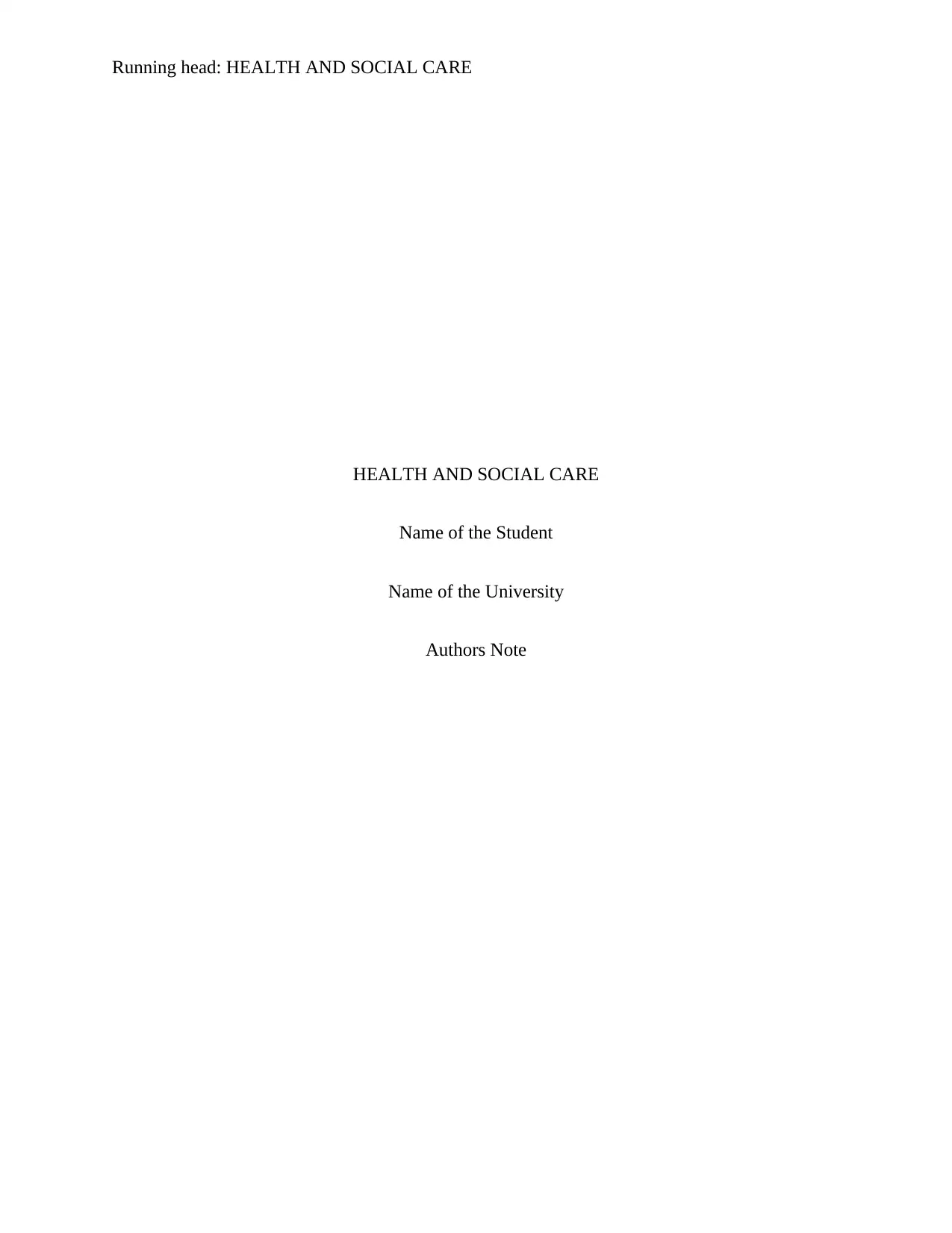
Running head: HEALTH AND SOCIAL CARE
HEALTH AND SOCIAL CARE
Name of the Student
Name of the University
Authors Note
HEALTH AND SOCIAL CARE
Name of the Student
Name of the University
Authors Note
Paraphrase This Document
Need a fresh take? Get an instant paraphrase of this document with our AI Paraphraser
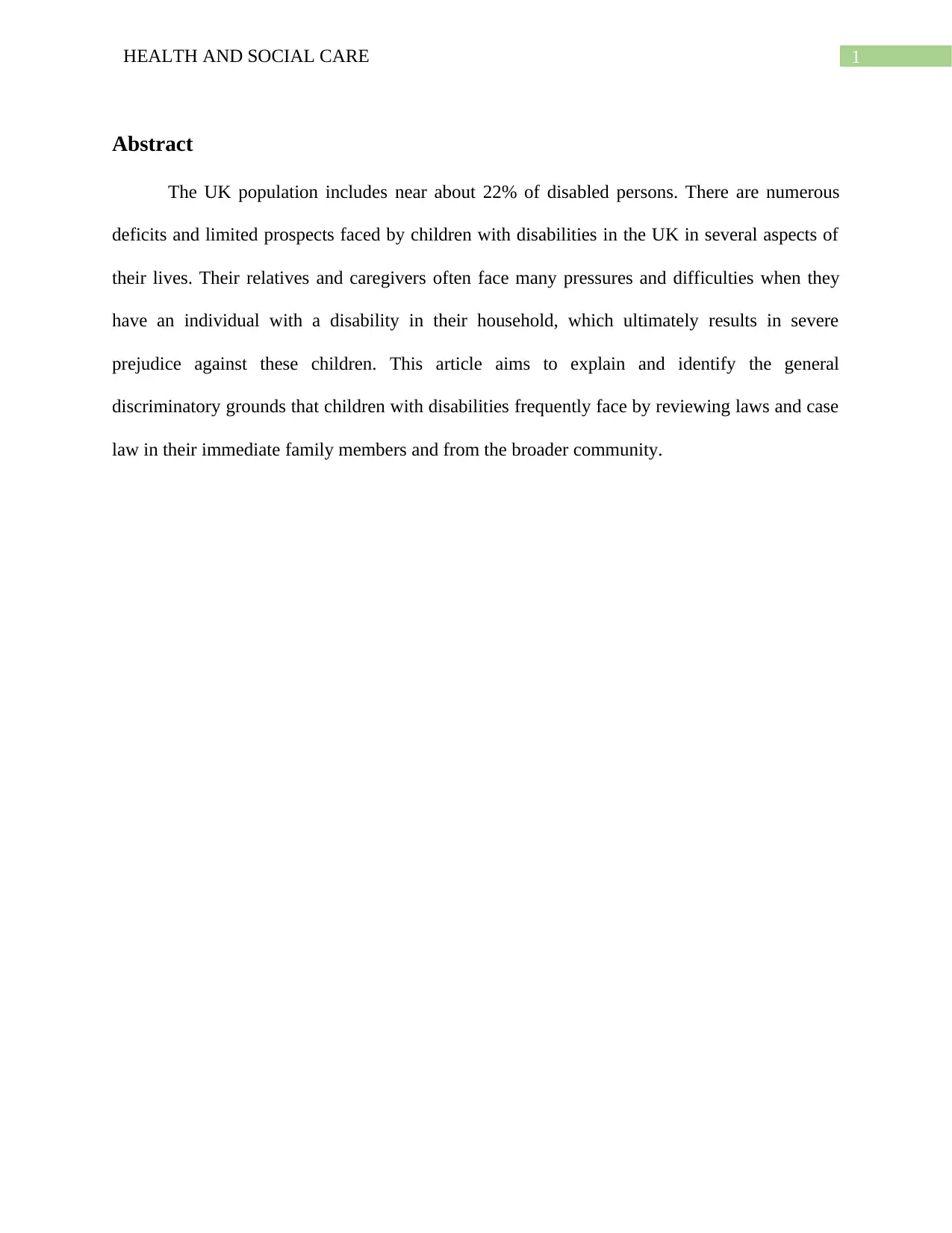
1HEALTH AND SOCIAL CARE
Abstract
The UK population includes near about 22% of disabled persons. There are numerous
deficits and limited prospects faced by children with disabilities in the UK in several aspects of
their lives. Their relatives and caregivers often face many pressures and difficulties when they
have an individual with a disability in their household, which ultimately results in severe
prejudice against these children. This article aims to explain and identify the general
discriminatory grounds that children with disabilities frequently face by reviewing laws and case
law in their immediate family members and from the broader community.
Abstract
The UK population includes near about 22% of disabled persons. There are numerous
deficits and limited prospects faced by children with disabilities in the UK in several aspects of
their lives. Their relatives and caregivers often face many pressures and difficulties when they
have an individual with a disability in their household, which ultimately results in severe
prejudice against these children. This article aims to explain and identify the general
discriminatory grounds that children with disabilities frequently face by reviewing laws and case
law in their immediate family members and from the broader community.
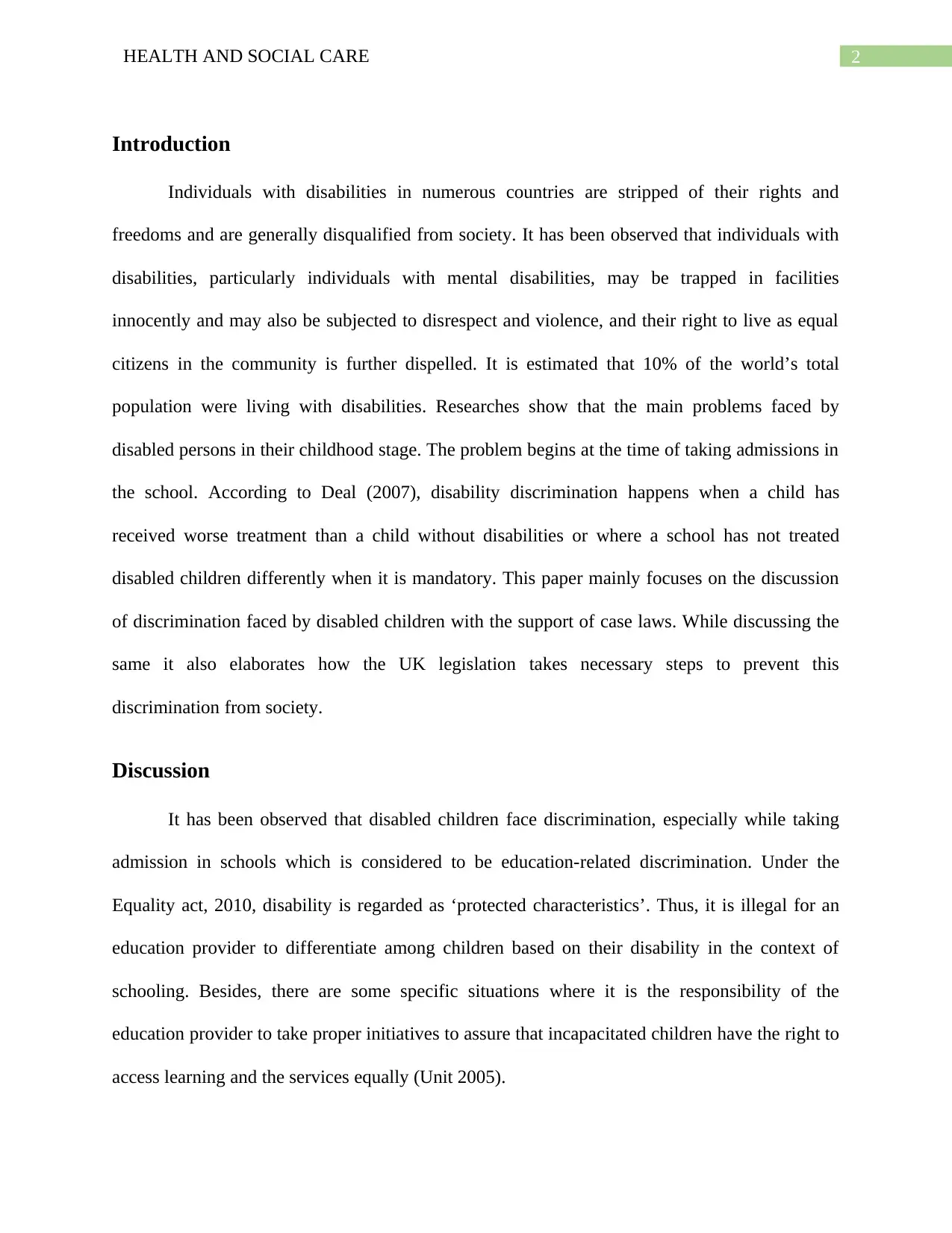
2HEALTH AND SOCIAL CARE
Introduction
Individuals with disabilities in numerous countries are stripped of their rights and
freedoms and are generally disqualified from society. It has been observed that individuals with
disabilities, particularly individuals with mental disabilities, may be trapped in facilities
innocently and may also be subjected to disrespect and violence, and their right to live as equal
citizens in the community is further dispelled. It is estimated that 10% of the world’s total
population were living with disabilities. Researches show that the main problems faced by
disabled persons in their childhood stage. The problem begins at the time of taking admissions in
the school. According to Deal (2007), disability discrimination happens when a child has
received worse treatment than a child without disabilities or where a school has not treated
disabled children differently when it is mandatory. This paper mainly focuses on the discussion
of discrimination faced by disabled children with the support of case laws. While discussing the
same it also elaborates how the UK legislation takes necessary steps to prevent this
discrimination from society.
Discussion
It has been observed that disabled children face discrimination, especially while taking
admission in schools which is considered to be education-related discrimination. Under the
Equality act, 2010, disability is regarded as ‘protected characteristics’. Thus, it is illegal for an
education provider to differentiate among children based on their disability in the context of
schooling. Besides, there are some specific situations where it is the responsibility of the
education provider to take proper initiatives to assure that incapacitated children have the right to
access learning and the services equally (Unit 2005).
Introduction
Individuals with disabilities in numerous countries are stripped of their rights and
freedoms and are generally disqualified from society. It has been observed that individuals with
disabilities, particularly individuals with mental disabilities, may be trapped in facilities
innocently and may also be subjected to disrespect and violence, and their right to live as equal
citizens in the community is further dispelled. It is estimated that 10% of the world’s total
population were living with disabilities. Researches show that the main problems faced by
disabled persons in their childhood stage. The problem begins at the time of taking admissions in
the school. According to Deal (2007), disability discrimination happens when a child has
received worse treatment than a child without disabilities or where a school has not treated
disabled children differently when it is mandatory. This paper mainly focuses on the discussion
of discrimination faced by disabled children with the support of case laws. While discussing the
same it also elaborates how the UK legislation takes necessary steps to prevent this
discrimination from society.
Discussion
It has been observed that disabled children face discrimination, especially while taking
admission in schools which is considered to be education-related discrimination. Under the
Equality act, 2010, disability is regarded as ‘protected characteristics’. Thus, it is illegal for an
education provider to differentiate among children based on their disability in the context of
schooling. Besides, there are some specific situations where it is the responsibility of the
education provider to take proper initiatives to assure that incapacitated children have the right to
access learning and the services equally (Unit 2005).
⊘ This is a preview!⊘
Do you want full access?
Subscribe today to unlock all pages.

Trusted by 1+ million students worldwide
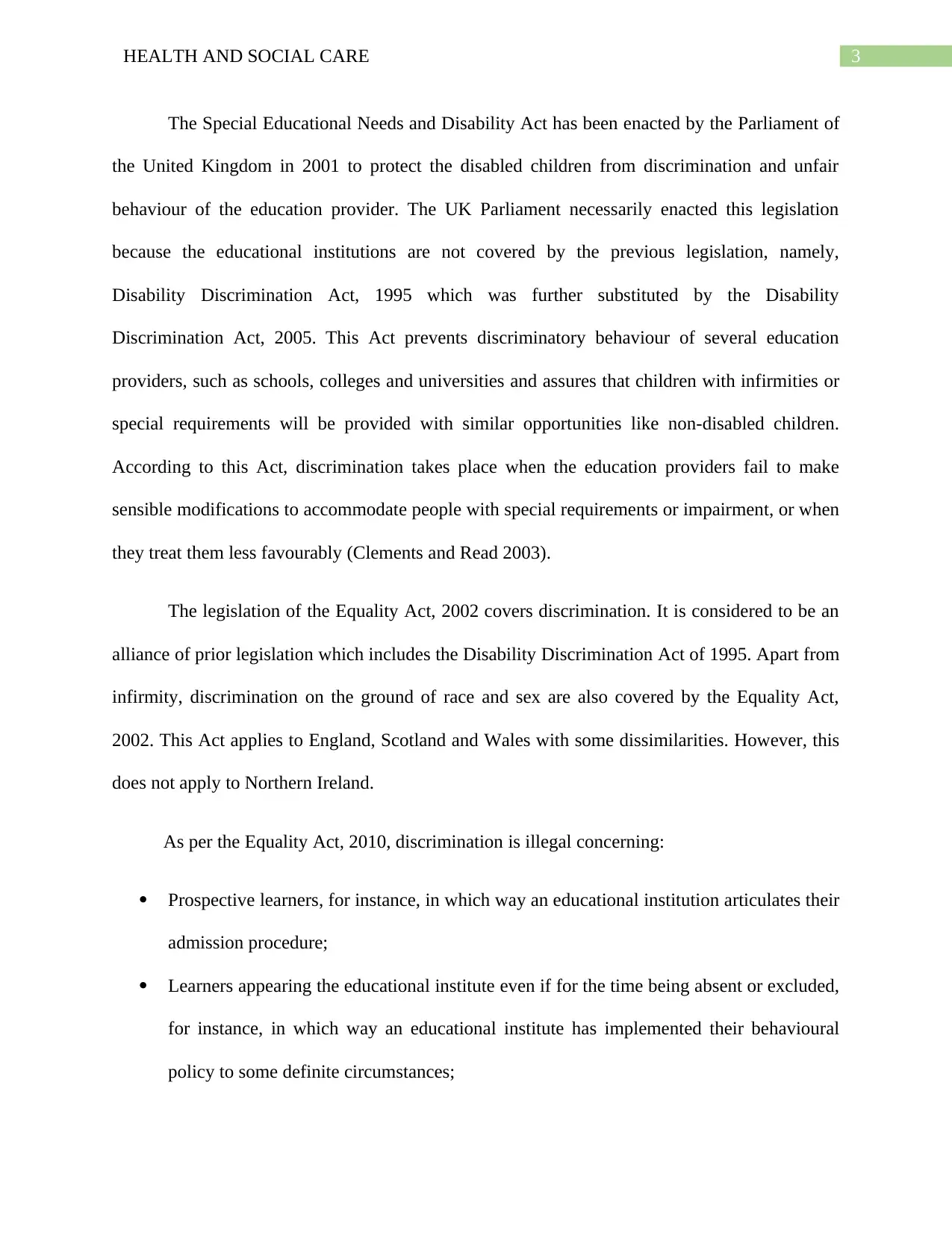
3HEALTH AND SOCIAL CARE
The Special Educational Needs and Disability Act has been enacted by the Parliament of
the United Kingdom in 2001 to protect the disabled children from discrimination and unfair
behaviour of the education provider. The UK Parliament necessarily enacted this legislation
because the educational institutions are not covered by the previous legislation, namely,
Disability Discrimination Act, 1995 which was further substituted by the Disability
Discrimination Act, 2005. This Act prevents discriminatory behaviour of several education
providers, such as schools, colleges and universities and assures that children with infirmities or
special requirements will be provided with similar opportunities like non-disabled children.
According to this Act, discrimination takes place when the education providers fail to make
sensible modifications to accommodate people with special requirements or impairment, or when
they treat them less favourably (Clements and Read 2003).
The legislation of the Equality Act, 2002 covers discrimination. It is considered to be an
alliance of prior legislation which includes the Disability Discrimination Act of 1995. Apart from
infirmity, discrimination on the ground of race and sex are also covered by the Equality Act,
2002. This Act applies to England, Scotland and Wales with some dissimilarities. However, this
does not apply to Northern Ireland.
As per the Equality Act, 2010, discrimination is illegal concerning:
Prospective learners, for instance, in which way an educational institution articulates their
admission procedure;
Learners appearing the educational institute even if for the time being absent or excluded,
for instance, in which way an educational institute has implemented their behavioural
policy to some definite circumstances;
The Special Educational Needs and Disability Act has been enacted by the Parliament of
the United Kingdom in 2001 to protect the disabled children from discrimination and unfair
behaviour of the education provider. The UK Parliament necessarily enacted this legislation
because the educational institutions are not covered by the previous legislation, namely,
Disability Discrimination Act, 1995 which was further substituted by the Disability
Discrimination Act, 2005. This Act prevents discriminatory behaviour of several education
providers, such as schools, colleges and universities and assures that children with infirmities or
special requirements will be provided with similar opportunities like non-disabled children.
According to this Act, discrimination takes place when the education providers fail to make
sensible modifications to accommodate people with special requirements or impairment, or when
they treat them less favourably (Clements and Read 2003).
The legislation of the Equality Act, 2002 covers discrimination. It is considered to be an
alliance of prior legislation which includes the Disability Discrimination Act of 1995. Apart from
infirmity, discrimination on the ground of race and sex are also covered by the Equality Act,
2002. This Act applies to England, Scotland and Wales with some dissimilarities. However, this
does not apply to Northern Ireland.
As per the Equality Act, 2010, discrimination is illegal concerning:
Prospective learners, for instance, in which way an educational institution articulates their
admission procedure;
Learners appearing the educational institute even if for the time being absent or excluded,
for instance, in which way an educational institute has implemented their behavioural
policy to some definite circumstances;
Paraphrase This Document
Need a fresh take? Get an instant paraphrase of this document with our AI Paraphraser
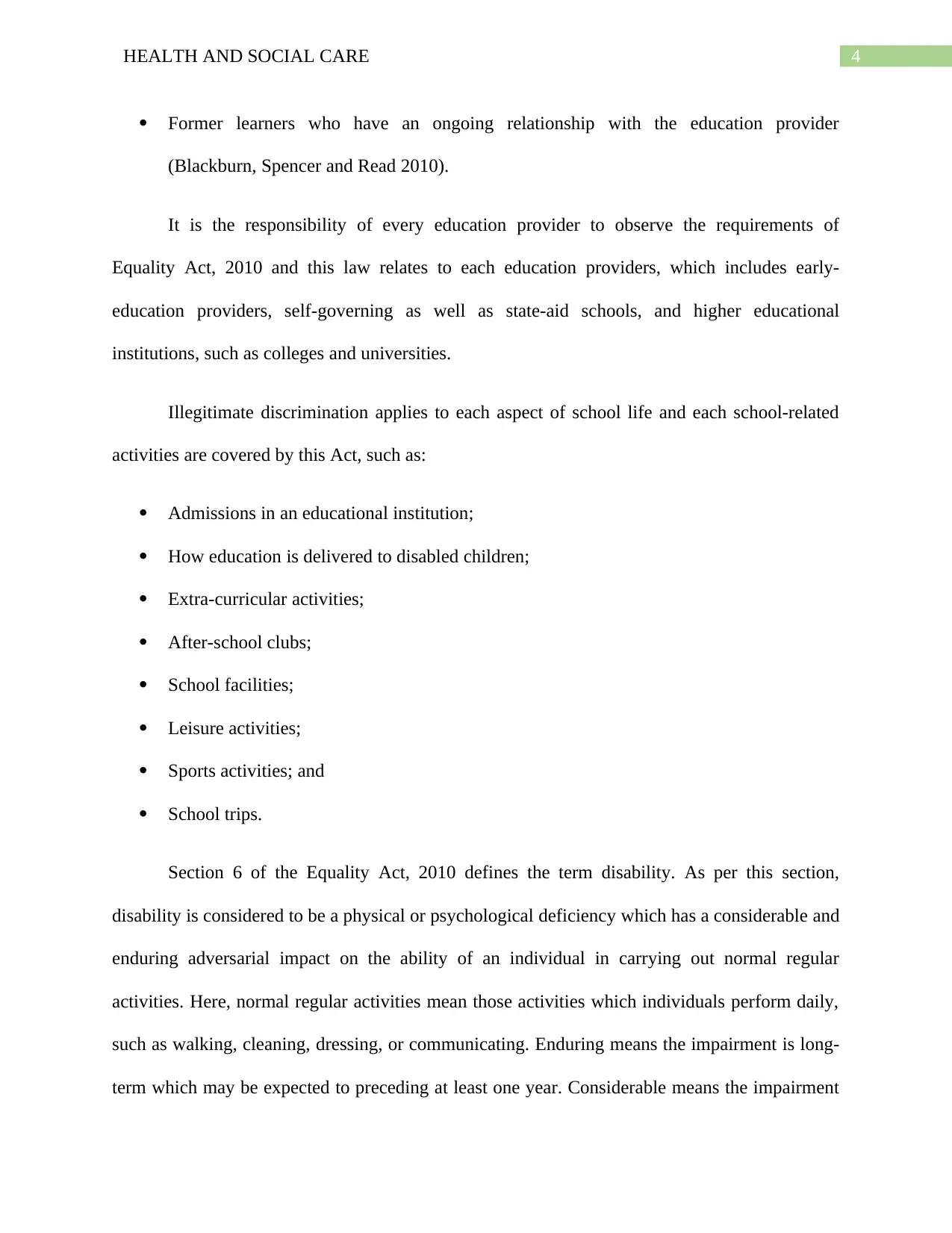
4HEALTH AND SOCIAL CARE
Former learners who have an ongoing relationship with the education provider
(Blackburn, Spencer and Read 2010).
It is the responsibility of every education provider to observe the requirements of
Equality Act, 2010 and this law relates to each education providers, which includes early-
education providers, self-governing as well as state-aid schools, and higher educational
institutions, such as colleges and universities.
Illegitimate discrimination applies to each aspect of school life and each school-related
activities are covered by this Act, such as:
Admissions in an educational institution;
How education is delivered to disabled children;
Extra-curricular activities;
After-school clubs;
School facilities;
Leisure activities;
Sports activities; and
School trips.
Section 6 of the Equality Act, 2010 defines the term disability. As per this section,
disability is considered to be a physical or psychological deficiency which has a considerable and
enduring adversarial impact on the ability of an individual in carrying out normal regular
activities. Here, normal regular activities mean those activities which individuals perform daily,
such as walking, cleaning, dressing, or communicating. Enduring means the impairment is long-
term which may be expected to preceding at least one year. Considerable means the impairment
Former learners who have an ongoing relationship with the education provider
(Blackburn, Spencer and Read 2010).
It is the responsibility of every education provider to observe the requirements of
Equality Act, 2010 and this law relates to each education providers, which includes early-
education providers, self-governing as well as state-aid schools, and higher educational
institutions, such as colleges and universities.
Illegitimate discrimination applies to each aspect of school life and each school-related
activities are covered by this Act, such as:
Admissions in an educational institution;
How education is delivered to disabled children;
Extra-curricular activities;
After-school clubs;
School facilities;
Leisure activities;
Sports activities; and
School trips.
Section 6 of the Equality Act, 2010 defines the term disability. As per this section,
disability is considered to be a physical or psychological deficiency which has a considerable and
enduring adversarial impact on the ability of an individual in carrying out normal regular
activities. Here, normal regular activities mean those activities which individuals perform daily,
such as walking, cleaning, dressing, or communicating. Enduring means the impairment is long-
term which may be expected to preceding at least one year. Considerable means the impairment
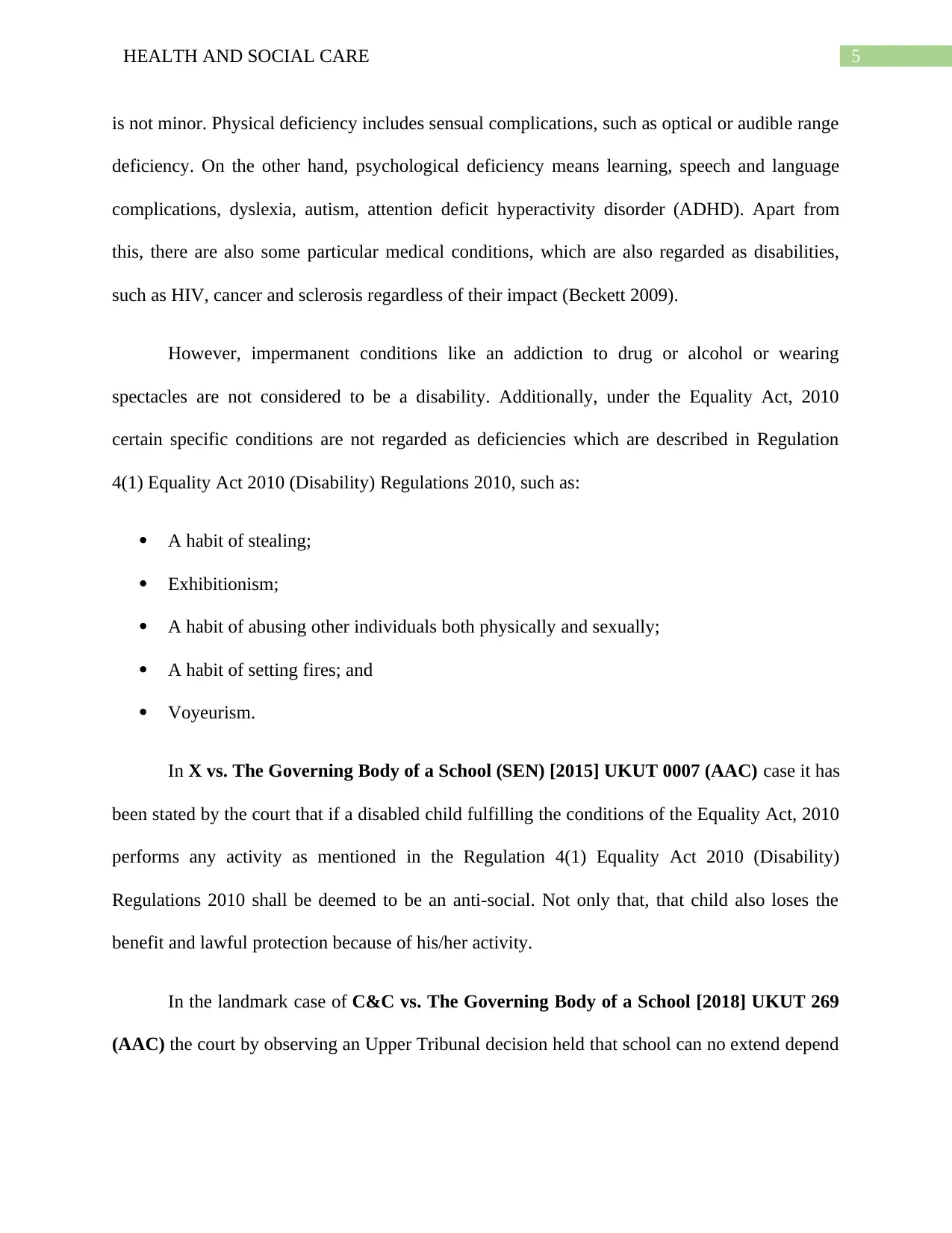
5HEALTH AND SOCIAL CARE
is not minor. Physical deficiency includes sensual complications, such as optical or audible range
deficiency. On the other hand, psychological deficiency means learning, speech and language
complications, dyslexia, autism, attention deficit hyperactivity disorder (ADHD). Apart from
this, there are also some particular medical conditions, which are also regarded as disabilities,
such as HIV, cancer and sclerosis regardless of their impact (Beckett 2009).
However, impermanent conditions like an addiction to drug or alcohol or wearing
spectacles are not considered to be a disability. Additionally, under the Equality Act, 2010
certain specific conditions are not regarded as deficiencies which are described in Regulation
4(1) Equality Act 2010 (Disability) Regulations 2010, such as:
A habit of stealing;
Exhibitionism;
A habit of abusing other individuals both physically and sexually;
A habit of setting fires; and
Voyeurism.
In X vs. The Governing Body of a School (SEN) [2015] UKUT 0007 (AAC) case it has
been stated by the court that if a disabled child fulfilling the conditions of the Equality Act, 2010
performs any activity as mentioned in the Regulation 4(1) Equality Act 2010 (Disability)
Regulations 2010 shall be deemed to be an anti-social. Not only that, that child also loses the
benefit and lawful protection because of his/her activity.
In the landmark case of C&C vs. The Governing Body of a School [2018] UKUT 269
(AAC) the court by observing an Upper Tribunal decision held that school can no extend depend
is not minor. Physical deficiency includes sensual complications, such as optical or audible range
deficiency. On the other hand, psychological deficiency means learning, speech and language
complications, dyslexia, autism, attention deficit hyperactivity disorder (ADHD). Apart from
this, there are also some particular medical conditions, which are also regarded as disabilities,
such as HIV, cancer and sclerosis regardless of their impact (Beckett 2009).
However, impermanent conditions like an addiction to drug or alcohol or wearing
spectacles are not considered to be a disability. Additionally, under the Equality Act, 2010
certain specific conditions are not regarded as deficiencies which are described in Regulation
4(1) Equality Act 2010 (Disability) Regulations 2010, such as:
A habit of stealing;
Exhibitionism;
A habit of abusing other individuals both physically and sexually;
A habit of setting fires; and
Voyeurism.
In X vs. The Governing Body of a School (SEN) [2015] UKUT 0007 (AAC) case it has
been stated by the court that if a disabled child fulfilling the conditions of the Equality Act, 2010
performs any activity as mentioned in the Regulation 4(1) Equality Act 2010 (Disability)
Regulations 2010 shall be deemed to be an anti-social. Not only that, that child also loses the
benefit and lawful protection because of his/her activity.
In the landmark case of C&C vs. The Governing Body of a School [2018] UKUT 269
(AAC) the court by observing an Upper Tribunal decision held that school can no extend depend
⊘ This is a preview!⊘
Do you want full access?
Subscribe today to unlock all pages.

Trusted by 1+ million students worldwide
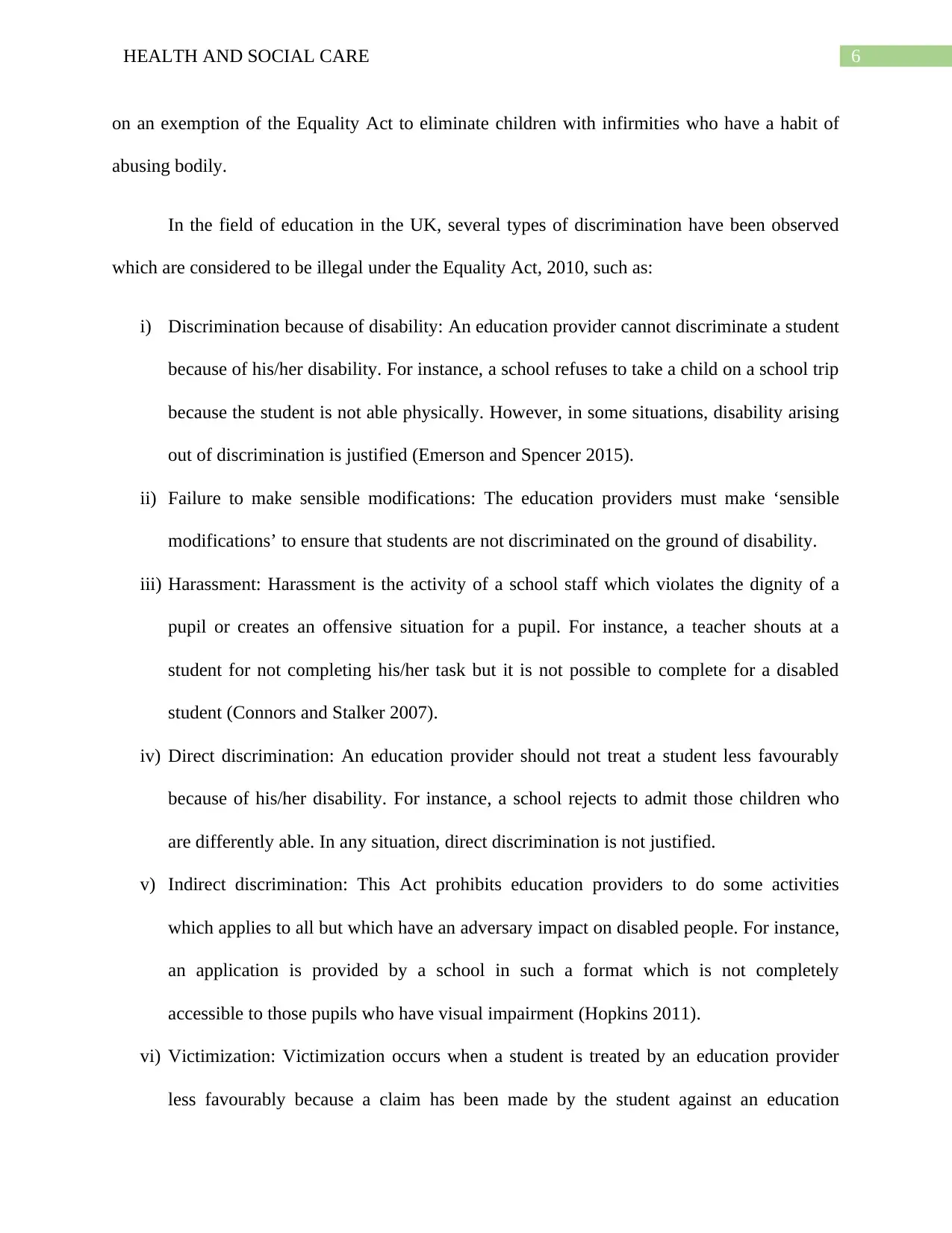
6HEALTH AND SOCIAL CARE
on an exemption of the Equality Act to eliminate children with infirmities who have a habit of
abusing bodily.
In the field of education in the UK, several types of discrimination have been observed
which are considered to be illegal under the Equality Act, 2010, such as:
i) Discrimination because of disability: An education provider cannot discriminate a student
because of his/her disability. For instance, a school refuses to take a child on a school trip
because the student is not able physically. However, in some situations, disability arising
out of discrimination is justified (Emerson and Spencer 2015).
ii) Failure to make sensible modifications: The education providers must make ‘sensible
modifications’ to ensure that students are not discriminated on the ground of disability.
iii) Harassment: Harassment is the activity of a school staff which violates the dignity of a
pupil or creates an offensive situation for a pupil. For instance, a teacher shouts at a
student for not completing his/her task but it is not possible to complete for a disabled
student (Connors and Stalker 2007).
iv) Direct discrimination: An education provider should not treat a student less favourably
because of his/her disability. For instance, a school rejects to admit those children who
are differently able. In any situation, direct discrimination is not justified.
v) Indirect discrimination: This Act prohibits education providers to do some activities
which applies to all but which have an adversary impact on disabled people. For instance,
an application is provided by a school in such a format which is not completely
accessible to those pupils who have visual impairment (Hopkins 2011).
vi) Victimization: Victimization occurs when a student is treated by an education provider
less favourably because a claim has been made by the student against an education
on an exemption of the Equality Act to eliminate children with infirmities who have a habit of
abusing bodily.
In the field of education in the UK, several types of discrimination have been observed
which are considered to be illegal under the Equality Act, 2010, such as:
i) Discrimination because of disability: An education provider cannot discriminate a student
because of his/her disability. For instance, a school refuses to take a child on a school trip
because the student is not able physically. However, in some situations, disability arising
out of discrimination is justified (Emerson and Spencer 2015).
ii) Failure to make sensible modifications: The education providers must make ‘sensible
modifications’ to ensure that students are not discriminated on the ground of disability.
iii) Harassment: Harassment is the activity of a school staff which violates the dignity of a
pupil or creates an offensive situation for a pupil. For instance, a teacher shouts at a
student for not completing his/her task but it is not possible to complete for a disabled
student (Connors and Stalker 2007).
iv) Direct discrimination: An education provider should not treat a student less favourably
because of his/her disability. For instance, a school rejects to admit those children who
are differently able. In any situation, direct discrimination is not justified.
v) Indirect discrimination: This Act prohibits education providers to do some activities
which applies to all but which have an adversary impact on disabled people. For instance,
an application is provided by a school in such a format which is not completely
accessible to those pupils who have visual impairment (Hopkins 2011).
vi) Victimization: Victimization occurs when a student is treated by an education provider
less favourably because a claim has been made by the student against an education
Paraphrase This Document
Need a fresh take? Get an instant paraphrase of this document with our AI Paraphraser
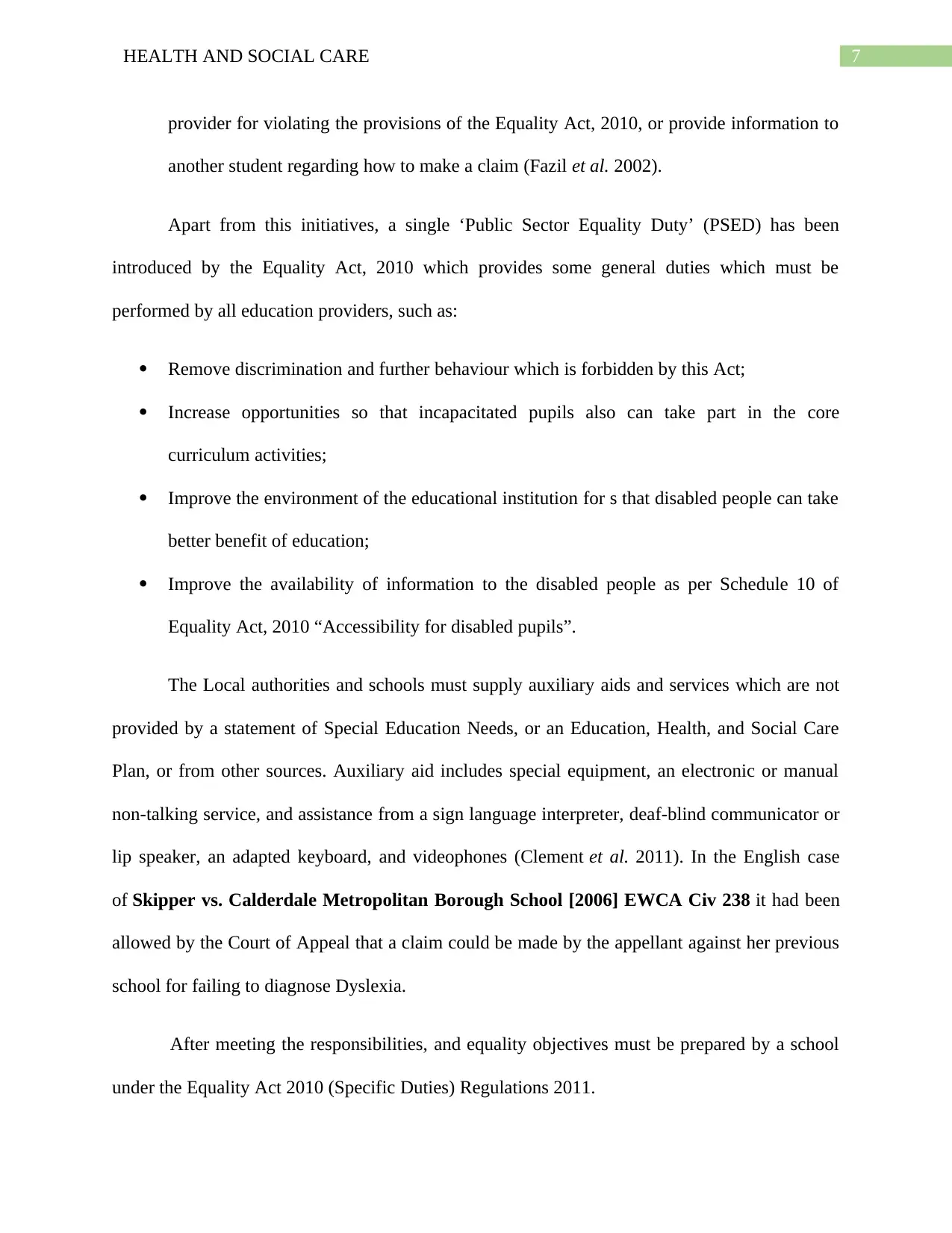
7HEALTH AND SOCIAL CARE
provider for violating the provisions of the Equality Act, 2010, or provide information to
another student regarding how to make a claim (Fazil et al. 2002).
Apart from this initiatives, a single ‘Public Sector Equality Duty’ (PSED) has been
introduced by the Equality Act, 2010 which provides some general duties which must be
performed by all education providers, such as:
Remove discrimination and further behaviour which is forbidden by this Act;
Increase opportunities so that incapacitated pupils also can take part in the core
curriculum activities;
Improve the environment of the educational institution for s that disabled people can take
better benefit of education;
Improve the availability of information to the disabled people as per Schedule 10 of
Equality Act, 2010 “Accessibility for disabled pupils”.
The Local authorities and schools must supply auxiliary aids and services which are not
provided by a statement of Special Education Needs, or an Education, Health, and Social Care
Plan, or from other sources. Auxiliary aid includes special equipment, an electronic or manual
non-talking service, and assistance from a sign language interpreter, deaf-blind communicator or
lip speaker, an adapted keyboard, and videophones (Clement et al. 2011). In the English case
of Skipper vs. Calderdale Metropolitan Borough School [2006] EWCA Civ 238 it had been
allowed by the Court of Appeal that a claim could be made by the appellant against her previous
school for failing to diagnose Dyslexia.
After meeting the responsibilities, and equality objectives must be prepared by a school
under the Equality Act 2010 (Specific Duties) Regulations 2011.
provider for violating the provisions of the Equality Act, 2010, or provide information to
another student regarding how to make a claim (Fazil et al. 2002).
Apart from this initiatives, a single ‘Public Sector Equality Duty’ (PSED) has been
introduced by the Equality Act, 2010 which provides some general duties which must be
performed by all education providers, such as:
Remove discrimination and further behaviour which is forbidden by this Act;
Increase opportunities so that incapacitated pupils also can take part in the core
curriculum activities;
Improve the environment of the educational institution for s that disabled people can take
better benefit of education;
Improve the availability of information to the disabled people as per Schedule 10 of
Equality Act, 2010 “Accessibility for disabled pupils”.
The Local authorities and schools must supply auxiliary aids and services which are not
provided by a statement of Special Education Needs, or an Education, Health, and Social Care
Plan, or from other sources. Auxiliary aid includes special equipment, an electronic or manual
non-talking service, and assistance from a sign language interpreter, deaf-blind communicator or
lip speaker, an adapted keyboard, and videophones (Clement et al. 2011). In the English case
of Skipper vs. Calderdale Metropolitan Borough School [2006] EWCA Civ 238 it had been
allowed by the Court of Appeal that a claim could be made by the appellant against her previous
school for failing to diagnose Dyslexia.
After meeting the responsibilities, and equality objectives must be prepared by a school
under the Equality Act 2010 (Specific Duties) Regulations 2011.
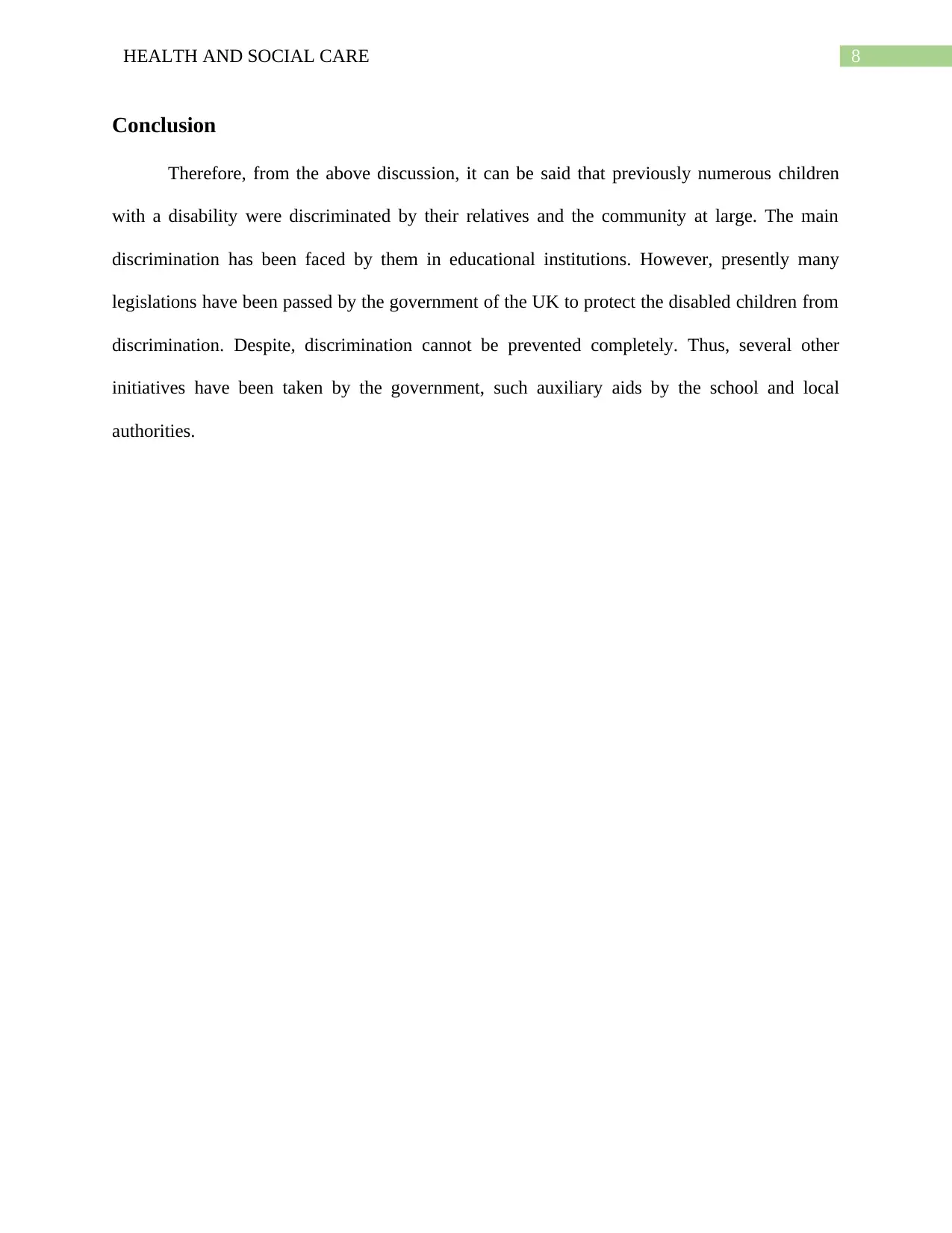
8HEALTH AND SOCIAL CARE
Conclusion
Therefore, from the above discussion, it can be said that previously numerous children
with a disability were discriminated by their relatives and the community at large. The main
discrimination has been faced by them in educational institutions. However, presently many
legislations have been passed by the government of the UK to protect the disabled children from
discrimination. Despite, discrimination cannot be prevented completely. Thus, several other
initiatives have been taken by the government, such auxiliary aids by the school and local
authorities.
Conclusion
Therefore, from the above discussion, it can be said that previously numerous children
with a disability were discriminated by their relatives and the community at large. The main
discrimination has been faced by them in educational institutions. However, presently many
legislations have been passed by the government of the UK to protect the disabled children from
discrimination. Despite, discrimination cannot be prevented completely. Thus, several other
initiatives have been taken by the government, such auxiliary aids by the school and local
authorities.
⊘ This is a preview!⊘
Do you want full access?
Subscribe today to unlock all pages.

Trusted by 1+ million students worldwide
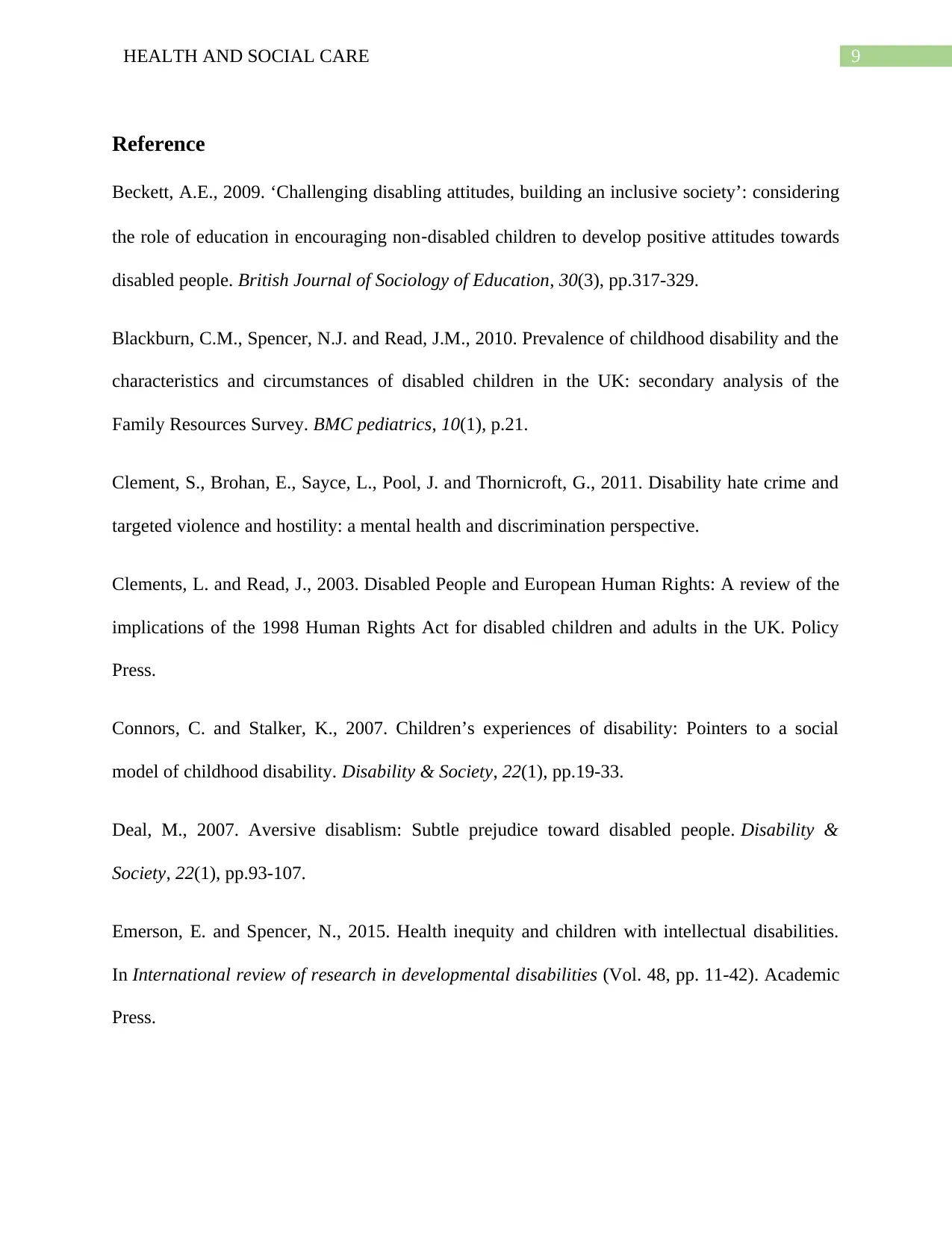
9HEALTH AND SOCIAL CARE
Reference
Beckett, A.E., 2009. ‘Challenging disabling attitudes, building an inclusive society’: considering
the role of education in encouraging non‐disabled children to develop positive attitudes towards
disabled people. British Journal of Sociology of Education, 30(3), pp.317-329.
Blackburn, C.M., Spencer, N.J. and Read, J.M., 2010. Prevalence of childhood disability and the
characteristics and circumstances of disabled children in the UK: secondary analysis of the
Family Resources Survey. BMC pediatrics, 10(1), p.21.
Clement, S., Brohan, E., Sayce, L., Pool, J. and Thornicroft, G., 2011. Disability hate crime and
targeted violence and hostility: a mental health and discrimination perspective.
Clements, L. and Read, J., 2003. Disabled People and European Human Rights: A review of the
implications of the 1998 Human Rights Act for disabled children and adults in the UK. Policy
Press.
Connors, C. and Stalker, K., 2007. Children’s experiences of disability: Pointers to a social
model of childhood disability. Disability & Society, 22(1), pp.19-33.
Deal, M., 2007. Aversive disablism: Subtle prejudice toward disabled people. Disability &
Society, 22(1), pp.93-107.
Emerson, E. and Spencer, N., 2015. Health inequity and children with intellectual disabilities.
In International review of research in developmental disabilities (Vol. 48, pp. 11-42). Academic
Press.
Reference
Beckett, A.E., 2009. ‘Challenging disabling attitudes, building an inclusive society’: considering
the role of education in encouraging non‐disabled children to develop positive attitudes towards
disabled people. British Journal of Sociology of Education, 30(3), pp.317-329.
Blackburn, C.M., Spencer, N.J. and Read, J.M., 2010. Prevalence of childhood disability and the
characteristics and circumstances of disabled children in the UK: secondary analysis of the
Family Resources Survey. BMC pediatrics, 10(1), p.21.
Clement, S., Brohan, E., Sayce, L., Pool, J. and Thornicroft, G., 2011. Disability hate crime and
targeted violence and hostility: a mental health and discrimination perspective.
Clements, L. and Read, J., 2003. Disabled People and European Human Rights: A review of the
implications of the 1998 Human Rights Act for disabled children and adults in the UK. Policy
Press.
Connors, C. and Stalker, K., 2007. Children’s experiences of disability: Pointers to a social
model of childhood disability. Disability & Society, 22(1), pp.19-33.
Deal, M., 2007. Aversive disablism: Subtle prejudice toward disabled people. Disability &
Society, 22(1), pp.93-107.
Emerson, E. and Spencer, N., 2015. Health inequity and children with intellectual disabilities.
In International review of research in developmental disabilities (Vol. 48, pp. 11-42). Academic
Press.
Paraphrase This Document
Need a fresh take? Get an instant paraphrase of this document with our AI Paraphraser
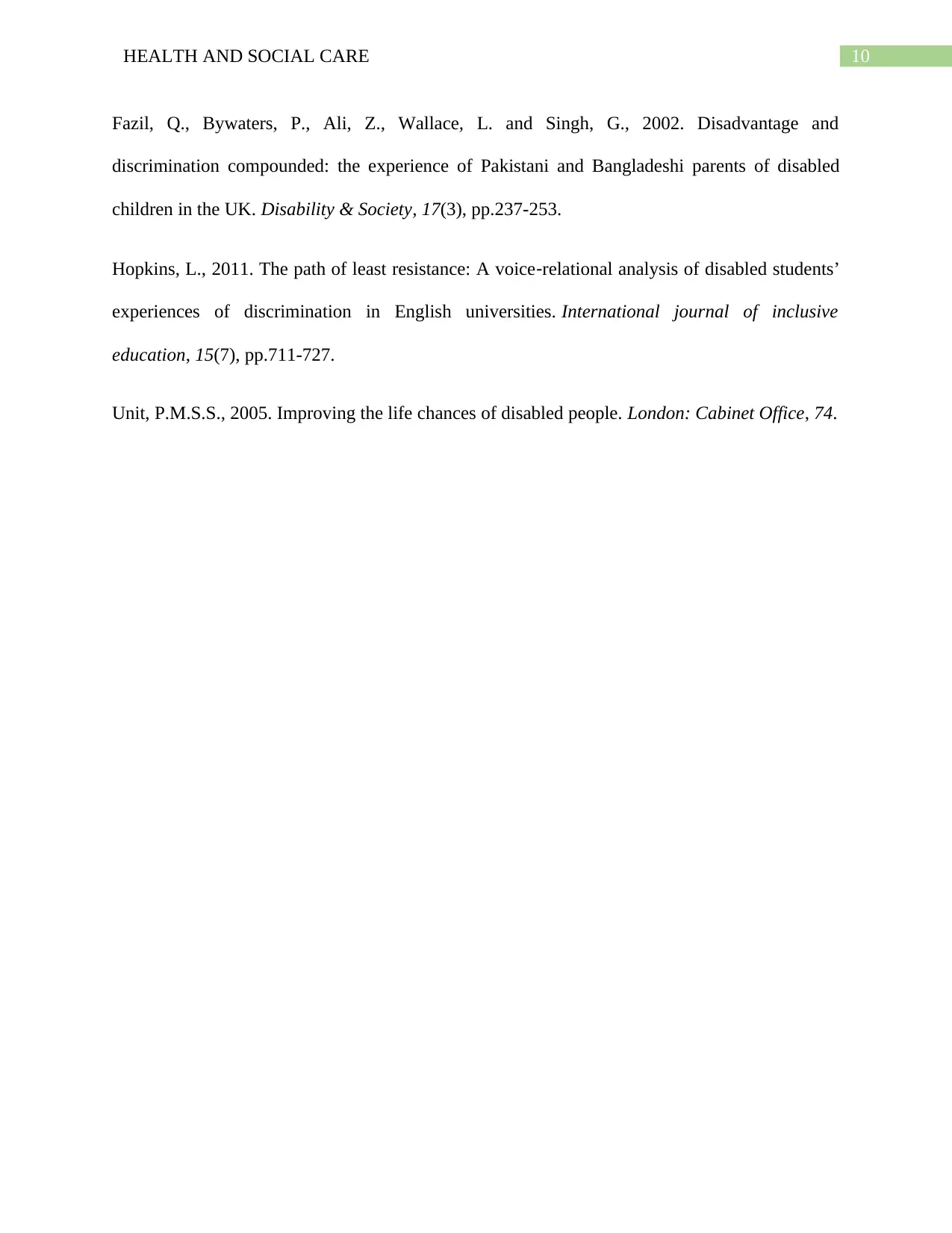
10HEALTH AND SOCIAL CARE
Fazil, Q., Bywaters, P., Ali, Z., Wallace, L. and Singh, G., 2002. Disadvantage and
discrimination compounded: the experience of Pakistani and Bangladeshi parents of disabled
children in the UK. Disability & Society, 17(3), pp.237-253.
Hopkins, L., 2011. The path of least resistance: A voice‐relational analysis of disabled students’
experiences of discrimination in English universities. International journal of inclusive
education, 15(7), pp.711-727.
Unit, P.M.S.S., 2005. Improving the life chances of disabled people. London: Cabinet Office, 74.
Fazil, Q., Bywaters, P., Ali, Z., Wallace, L. and Singh, G., 2002. Disadvantage and
discrimination compounded: the experience of Pakistani and Bangladeshi parents of disabled
children in the UK. Disability & Society, 17(3), pp.237-253.
Hopkins, L., 2011. The path of least resistance: A voice‐relational analysis of disabled students’
experiences of discrimination in English universities. International journal of inclusive
education, 15(7), pp.711-727.
Unit, P.M.S.S., 2005. Improving the life chances of disabled people. London: Cabinet Office, 74.
1 out of 11
Related Documents
Your All-in-One AI-Powered Toolkit for Academic Success.
+13062052269
info@desklib.com
Available 24*7 on WhatsApp / Email
![[object Object]](/_next/static/media/star-bottom.7253800d.svg)
Unlock your academic potential
Copyright © 2020–2025 A2Z Services. All Rights Reserved. Developed and managed by ZUCOL.





